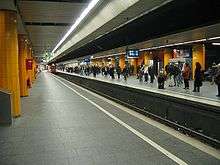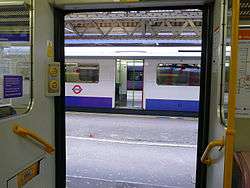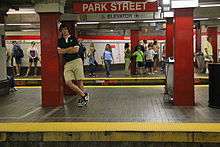Spanish solution
 Spanish solution: the principle  Eastbound track at Station Marienplatz, Munich S-Bahn   Looking from one train through another, with doors open on both sides, to a third train. At Barking in London, England eastbound Underground trains open their doors on both sides for cross-platform interchange with two main-line services, C2C and London Overground Barking - Gospel Oak, this photograph from inside one of the latter.  Westbound platforms 3 and 3a at Stratford station (with a London Underground Central line train arriving). Trains now open their doors on both sides at this platform. | |||||||||||||||||||||||||||||||||||||||||||||||||||||||||||||||
The Spanish solution (also called Barcelona solution) has two railway platforms, one on each side of the line, to speed up boarding and alighting: passengers board from one side and alight to the other. If there are three platforms (one island platform and two side platforms) with two tracks, generally the center platform will be a shared exit platform, as there is no benefit in segregating arriving passengers. At most locations doors for exit open a few seconds before those for entry.
The principle was first used in 1895 at the (now closed) King William Street tube station in London, but came into wide use on (and takes its name from) the Barcelona Metro in the 1930s.
The solution was used in the United States in 1912 at Park Street Under on the MBTA's Red Line in Boston, and at Chambers Street on the New York City Subway in 1913, where the center platform is now closed.
On people movers at airports there are often dedicated platforms for boarding and alighting. This can have the additional advantage of preventing travellers heading in the wrong direction when alighting, and ensuring passenger segregation. The same principle is often used on ferries, monorails, and cable cars, fairground rides such as roller coasters, lifts (for instance on the London Underground) and in buildings such as theaters.
At a terminal station where trains are bi-directional (double ended) it is advantageous for the center platform to be for boarding and the side platforms to be for alighting. This permits an incoming train to enter on either track and remain in the station until it is ready to begin the next trip. Passengers boarding then do not have to know in advance which track the next train will depart from.
Examples
Sé on the São Paulo Metro is a recent example. Line 1 Blue (Linha 1 - Azul, Norte-Sul or North-South) uses this model at stations like Sé, a busy station due to Line 3 integration, and Line 3 - Red (Linha 3 - Vermelha, Leste-Oeste or East-West) uses this at Sé, Republic (Estação República), Itaquera, Barra Funda, and Luz.
In Hong Kong, the former KCRC (now part of MTR Corporation) reconstructed the platforms at the checkpoint terminus, Lo Wu, to a similar layout. When the train stops, the doors on the island (alighting) platform open and all passengers get off. Then the doors close and the doors on the side (boarding) platform open.
In France, the principle is applied at the Line B platforms at Jean Jaurès on the Toulouse Metro, where Lines A and B connect.
On the London Underground system, Loughton tube station was designed as an example, in this case to allow interconnection across the platforms with trains from beyond; though it is no longer operated on the principle.
Other examples
Asia
- People's Republic of China
- Gongyuanqian and Xilang on the Guangzhou Metro.
- In Shanghai, the southbound Line 8 platform at People's Square doors open on both sides, but passengers enter only from the left, encouraging exit to the right.
- Luohu Station and Futian Checkpoint Station of Shenzhen Metro
- In the Beijing Subway, Xizhimen Station Line 13 platforms, Terminal 3 Station, Songjiazhuang Station Yizhuang Line platforms, and Haidian Wuluju Station.
- Chengdu Metro Tianfu Square Line 1 platforms.
- Tianjin Metro Tianjinzhan Station Line 9 Platforms
- Beijing Capital International Airport Terminal 3 shuttle
- Hong Kong
- India
- Chhatrapati Shivaji Terminus
- First platform of Jogeshwari railway station.
- First platform of Kurla railway station.
- First platform of Dombivli railway station.
- Noapara Metro Station of Kolkata Metro (Line 1).
- Japan
- Ikebukuro Station on the Seibu Ikebukuro Line and Tōbu Tōjō Line
- Sakuragichō Station on the Keihin-Tōhoku Line
- Keiō Line terminus at Shinjuku Station
- Odakyu Line terminus at Shinjuku Station
- Korea
- Panam Station, the eastern terminus of Daejeon Subway Line 1
- Malaysia
- KLIA AeroTrain terminus at KLIA Main Terminal Building & KLIA Satellite Terminal Building A
- KL Monorail terminus at KL Sentral Station & Titiwangsa Station
- Singapore
- Sentosa Station terminus along Sentosa Express at VivoCity.
- Changi Airport Skytrain terminus at every terminal between separation between Public and Transit Area between Terminal 2 and Terminal 3.
- Choa Chu Kang LRT platform will transform from an Island platform to the Spanish Solution. It will also be the first in Singapore to have an Island Platform upgraded to a Spanish Solution Platform. The main platform is still for boarding but the side platforms are only for exits.
- Thailand
- Chachoengsao Junction on SRT Eastern Line.
Israel
Australasia
- Australia
- Olympic Park railway station, Sydney
- Skitube stations at Bullocks Flat and Perisher Valley
- Glanville, Brighton and Noarlunga Centre in Adelaide (one track only)
Europe
- Austria
- Stadion, on Vienna U-Bahn line U2, to allow faster boarding after events in the nearby Ernst-Happel-Stadion.
- Belgium
- Premetro tram stations between Brussels-South and Brussels-North on the North-South Brussels Metro, and Rogier on Line 2
- Denmark
- Holte on S-train line B, north of Copenhagen
- France
- Jean Jaurès, on Toulouse Metro line B
- Hôtel de ville - Louis Pradel, on Lyon Metro line C
- Charles de Gaulle – Étoile, on Paris Métro Line 6
- Germany
- S-Bahn: München Hauptbahnhof and Karlsplatz with island platform for boarding and side platforms for alighting, Marienplatz with eastbound track at upper level and westbound track at lower level - both have separate platforms for boarding and alighting.
- Stuttgart Stadtbahn: Pragsattel, Mineralbäder
- Greece
- Omonoia station in Athens Metro Line 1.
- Poland
- Warszawa Śródmieście in Warsaw – for many years until the late 1980s

- Spain
- Barcelona Airport T2 station
- The train station at Barcelona airport has been updated from 2 tracks, each with a single platform; to a single track with a boarding platform one side and alighting platform on the other.
- Barcelona Metro
- Glòries, Clot, Navas, Fabra i Puig, Sant Andreu on line 1.
- Catalunya, Muntaner, La Bonanova and Avinguda Tibidabo on lines 6 and 7.
- Old Santa Eulàlia station (line 1), Catalunya line 1 temporary station, La Sagrera (lines 1 and 5), Passeig de Gràcia (line 3), Diagonal (line 3) and Correos ghost station (line 4) used to have this configuration.
- Madrid Metro
- Miguel Hernández on line 1.
- Campamento and Carabanchel on line 5.
- Avenida de América, Manuel Becerra, Sáinz de Baranda, Pacífico, Plaza Elíptica, Oporto and Laguna on Line 6.
- Lago and Plaza de España stations on line 10 had three platforms until the late 1990s.
- Turkey
- Kızılay station on Ankara Metro M1 line.
- Otogar(Coach Station) station on Istanbul Metro M1 line
- Yenikapı station on Istanbul Metro M2 line
- Bostancı station on Istanbul Metro M4 line
- United Kingdom
- Tower Gateway station was rebuilt from a two-platform island terminus to a two-platform single-track terminus, though in practice passengers are directed to alight via the north platform face and board via the south platform face.
- Gatwick Airport shuttle train between North and South terminals
- shuttle transit beneath A, B and C gates at London Heathrow Terminal 5
Stations where there are two platforms for one track, but passengers can board and alight from either side:
- Docklands Light Railway (DLR)
- Canary Wharf has six platforms serving three tracks.
- London Underground
- Barking - eastbound District line
- Stratford - westbound Central line
- Golders Green - turnback (reversible) line. The northbound line could be used this way, but platform 1 is not available for public use.
- Morden - platforms 3 and 4 of the three-track terminus (platform 1 is out of use, with doors opening onto platform 2)
- Uxbridge and Cockfosters - three-track termini where the centre track shares platform islands with the outer tracks
- White City and Loughton - second and third platforms.
- Manchester Metrolink
- Manchester Victoria station - station design under construction gives a central platform for cross-platform interchange onto and off services via Second City Crossing
- National Rail
- Guildford - platforms 6 and 7 flank the same track, but trains serve only Platform 6. Platform 7 forms an island with Platform 8.
- Norwood Junction - platforms 1 and 2, "Up Local", could be used in this way, but the Office of Rail Regulation does not allow it.
- Preserved Railways
- Horsted Keynes on the Bluebell Railway - platforms 4 and 5
North America

- Canada
- Toronto Subway and RT:
- Kennedy on the Scarborough RT line
- Sheppard–Yonge on the Sheppard line — Spanish solution designed but not in use.
- GO Transit
- Union Station on the Lakeshore West line and Lakeshore East line
- TransLink (Vancouver)
- SeaBus - Waterfront Station to Lonsdale Quay, North Vancouver - a marine application of the Spanish Solution, in place since 1977.
- United States
- Boston Park Street (MBTA station), lower level
- Stations in the New York City Subway are designed in the Spanish solution, but the side platforms at many of these stations have been closed:
- Woodlawn
- Wakefield – 241st Street
- Pelham Bay Park
- Van Cortlandt Park – 242nd Street
- 96th Street (local tracks only)
- 59th Street – Columbus Circle (express tracks only)
- 14th Street – Union Square (local tracks only)
- Brooklyn Bridge – City Hall (local tracks only)
- Chambers Street (easternmost three tracks only, formerly all tracks)
- Hoyt–Schermerhorn Streets (Fulton Street line express tracks only)
- Bowling Green (mainline tracks only; easternmost island platform has since been walled off to northbound trains, and westernmost island platform has since been closed)
Other stations, mainly express stations on three-track lines, have a Spanish solution for the middle track, but trains often open the doors on only one side, depending on the direction of travel. Two terminal stations that retain a Spanish solution are the N R platforms at South Ferry - Whitehall Street, and Flushing – Main Street – the terminal for the 7 <7> trains, but the doors cannot open on both sides, due to constraints on newer rolling stocks.
- PATH tracks at Newark Penn Station in Newark, New Jersey has two out of three tracks using the Spanish solution, while 33rd Street in Manhattan and Hoboken Terminal in Hoboken have all three tracks using the Spanish solution.
- Stamford station in Stamford, Connecticut has two tracks that utilize the Spanish solution.
- Park Street Lower on the MBTA plus outbound Green Line C and E branch trains on Park Street's upper level and at Sullivan Square and Wellington on the Orange Line (both outbound only).
- Five Points, and Lindbergh Center (on northbound side) stations of the Atlanta MARTA.
- Epcot, Transportation and Ticket Center, and Magic Kingdom on the Walt Disney World Monorail System
- Long Island Rail Road - at Jamaica, three trains are often timed to arrive at tracks 1–3 and tracks 6–8, allowing passengers to walk through the center train to transfer between trains on the outer tracks. Ronkonkoma also uses a Spanish solution.
- White Plains Metro-North (outbound trains only)
- Tracks 1 and 4 in SEPTA's Suburban Station in Philadelphia, towards Jefferson Station and beyond, contain what appears to be a Spanish solution, as those tracks share the (narrow) platforms which serve stub-end tracks 0 and 5 in addition to the wide platforms which serve through tracks 1-2 and 3-4. However, for logistical and safety reasons, this setup has seldom if ever been used; it is more of an artefact from when the platforms between tracks 1-2 and 3-4 were widened at the expense of two stub-end tracks to accommodate the Center City Commuter Connection which opened in 1984 (Market East, by comparison, has only two island platforms for its four tracks). However, the tracks at the stations at Philadelphia International Airport Terminals A, B, and C & D on the SEPTA Airport Line do actively use a form of the Spanish solution; because baggage claim at the airport is in a separate building connected to the main airport terminals by skyways, at these stations, there are two tracks, with a single island platform between them used both by all alighting passengers and by those boarding passengers who have not arrived from baggage claim (including both travelers with no checked baggage and airport workers), and a single side platform dedicated to boarding passengers who have arrived from baggage claim.
- Denver International Airport: the airside people mover station underneath the Jeppesen Terminal is configured with passengers boarding from the central platform and alighting to the side platforms. The Spanish solution is also used for people mover systems at airports in Pittsburgh, Orlando, Tampa, Las Vegas, and Sacramento.
- Mexico
- Metro Chabacano on lines 2, 8, and 9 of the Mexico City Metro
- Salto del Agua, Bellas Artes, and Garibaldi Lagunilla on line 8 of the Mexico City Metro
South America
- Argentina
- Constitución and Retiro on Line C in Buenos Aires

- Brazil

- Venezuela
- Simón Bolívar commuter rail station in Caracas.
External links
 Media related to Spanish solution at Wikimedia Commons
Media related to Spanish solution at Wikimedia Commons
| ||||||||||||||||||||||||||